An in-depth data analysis of No. 3 Stanford women’s swimming performances ahead of the 2023 NCAA Division I Women’s Swimming & Diving Championships in Knoxville, Tenn. this week suggests that the Cardinal could be set to surpass last season’s performances in the all-important relay events.
Having last won a national title in 2019, its third in a three-peat, Stanford finished third in the overall points standings at NCAAs last season with a medal haul of 10, a total that included silverware in three out of their five relays.
Now, headed into this year’s edition of the national championships with four of five relays already ranked in the top three, Stanford will aim to unseat No. 2 Texas and No. 1 Virginia and ascend to college swimming’s pinnacle once more, beginning Wednesday, March 15.
Ready, set, relay
Relays, the ultimate display of a program’s depth of talent, are worth double the points available in individual events. This means twice as many points are up for grabs to either launch one’s team up the rankings or lose substantial ground.
The prestige of being handed a spot on one of the sport’s five relay events — the 200 and 400-yard medleys, and the 200, 400 and 800-yard freestyle relays — is something swimmers strive to achieve during their years of NCAA eligibility.
“Qualifying for relays is a big deal,” said women’s swimming head coach Greg Meehan. A three-time Women’s NCAA Coach of the Year, this is Meehan’s 11th season on The Farm.
“It gets competitive in a healthy way; it usually draws out pretty good performances [throughout the year] because they want to be on that relay at the end of the season,” he said.
There is also strategy in a coach’s selections for each relay. Earlier in the season, Meehan explained a conundrum.
“We’re fortunate in that we have three absolute studs that we can put onto different relays,” Meehan said, referencing the globetrotting trio of freshman Claire Curzan, sophomore Torri Huske and redshirt senior Taylor Ruck. “But at the same time, it takes more than three to be successful.”
“They [Ruck, Huske and Curzan] will swim three individual events,” Meehan said. “So they have to come off one [relay] and taking them off the same one doesn’t make as much sense, right? So it’s strategic.”
With athletes limited to seven events total at championship meets, including a maximum of three individual races, each swimmer may only swim four out of the five possible relays (or, one may swim all five relays by sacrificing an individual entry).
Pac-12 round-up
The Cardinal retained its Pac-12 conference crown last month, and in doing so has already beaten its best performances from last season in two out of five relays.
On the way to that title defense in Federal Way, Wash., Meehan constructed quartets that finished first (by a sizable margin) in all but one of the five relay events, setting four season best times along the way.
Explaining that the team was split “about 50-50” between resting for Pac-12s versus training through their penultimate meet of the season with a full focus on NCAAs, he also hinted at potential tweaks to their upcoming relay line-ups in Knoxville.
“We’re constantly thinking about the right combinations,” Meehan said. “We tinkered a little bit with our relays at Pac-12s compared to midseason, and then it’s going to look a little bit different for at least two of the relays as we move into NCAAs.”
But how did those relays perform, and where do they position the Cardinal on its path to the national title?
Read on for analysis comparing Stanford’s two most recent seasons, how their current bests stack up against the rest of the nation’s elite, and the NCAA’s progression in each event over the last decade of national championship competition.
200-yard freestyle relay
- Placing at 2021-22 NCAAs: 6th
- Ranking pre-NCAAs 2022-23: 3rd
- Chance of 2022-23 podium finish, based on analysis: Good shot.
One of the two relays where this season’s best is already faster than any time achieved last season, the 200-yard freestyle relay represents Stanford’s biggest potential jump up the national rankings.
At Pac-12s, both Ruck and Huske kept their places from the team that placed sixth at NCAAs last year, while Curzan and sophomore Amy Tang threw down strong splits on the other two legs for the win in Washington last month.
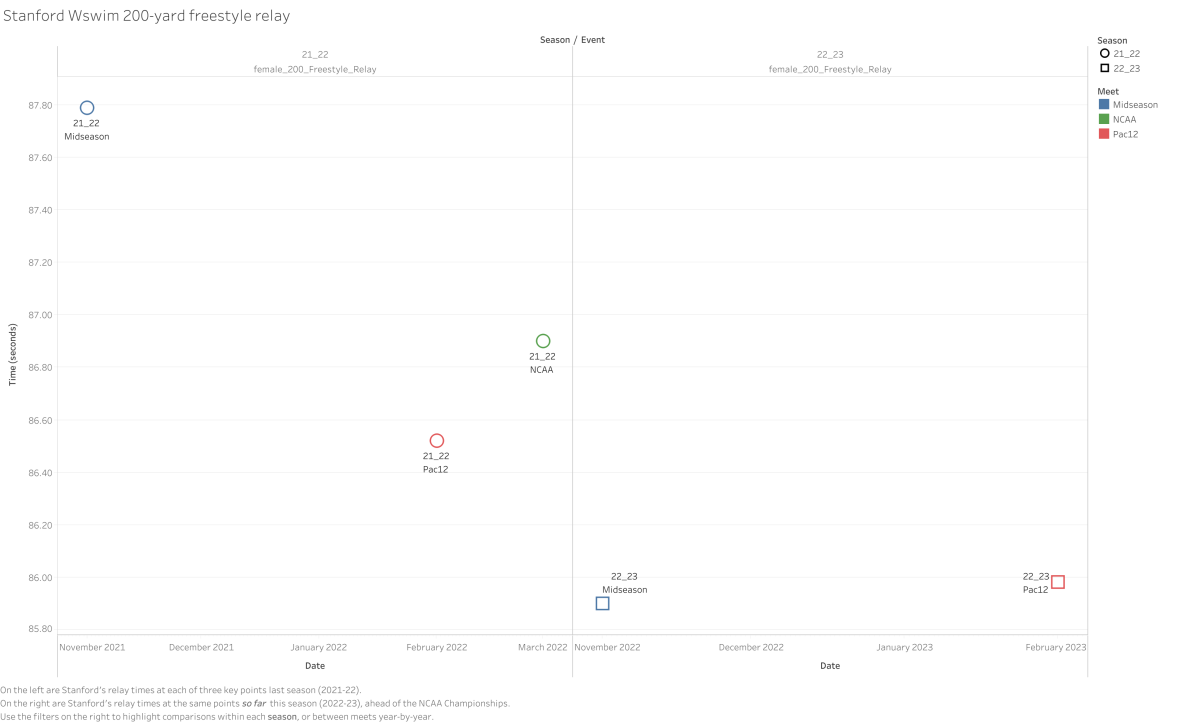
That Pac-12 performance of 1:25.98 was just fractionally slower than Stanford’s midseason mark, but both times are still half a second quicker than last season’s best.
This season’s best, 1:25.90, is also exactly a second faster than the Cardinal’s time at the 2022 NCAAs, and places the team comfortably ahead of all previous standards for a bronze medal.
Ranked third behind Louisville (1:25.29) and Virginia (1:23.87) coming into the national championships, Stanford’s coach fancies his team’s chances.
“I think we could win that one,” Meehan said. “That would be huge.”
200-yard medley relay
- Placing at 2021-22 NCAAs: 10th
- Ranking pre-NCAAs 2022-23: 10th
- Chance of 2022-23 podium finish, based on analysis: On the cusp.
Stanford’s longest stretch without an NCAA relay medal lies in the 200-yard medley relay, the first event on the championship meet schedule.
Last season, a time of 1:34.97 saw them take 10th in the country at NCAAs, hindered by former Card Regan Smith’s unfortunate slipped turn.
Despite being quicker mid-season compared to 2021-22, this year’s Pac-12-winning time (1:35.42) was three quarters of a second slower than at the same stage last year.
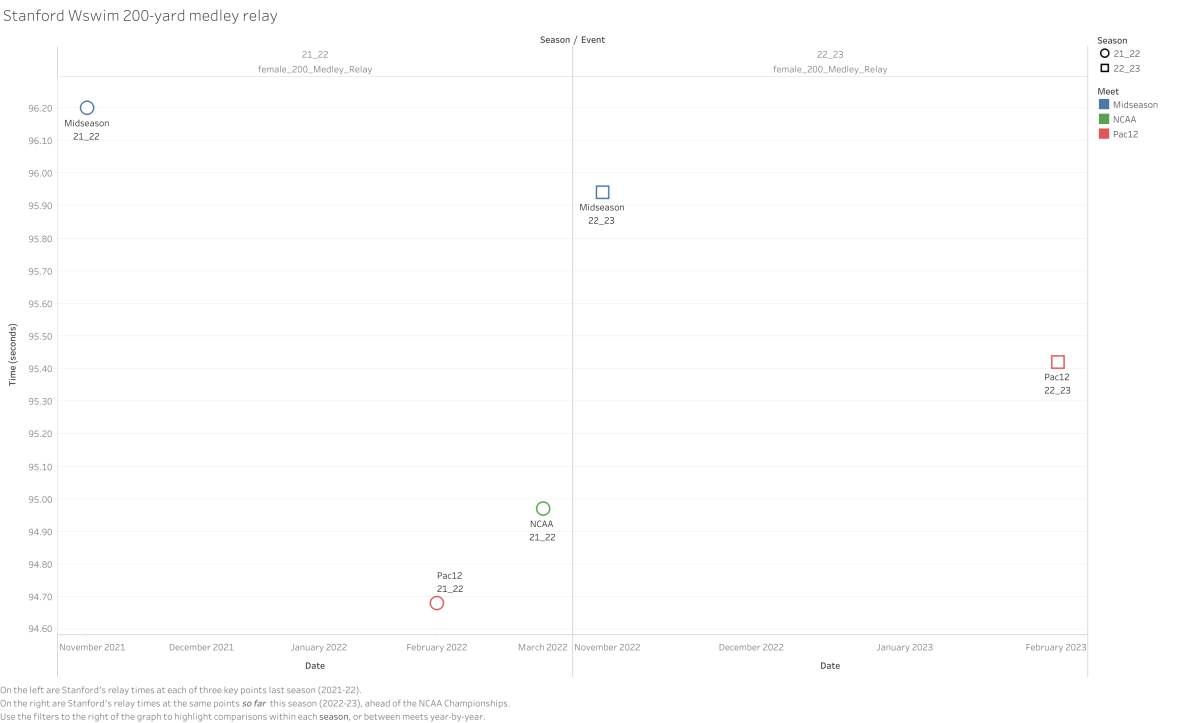
That season-best time came from a team comprising Curzan (backstroke), seniors Allie Raab (breaststroke) and Emma Wheal (butterfly), and Ruck (freestyle), with only Raab and Wheal returning from the NCAA team last March.
Still, the same margin of time (0.72 seconds) separates Stanford’s season best from that of Texas, who occupy the third spot in the entry list.
If they can avoid a similar misfortune to Smith’s mishap this year, there is every chance that a fully rested foursome, however Meehan chooses to assemble them, could climb the rankings and at least put the top-three on notice.
400-yard freestyle relay
- Placing at 2021-22 NCAAs: 2nd
- Ranking pre-NCAAs 2022-23: 2nd
- Chance of 2022-23 podium finish, based on analysis: Good shot.
Stanford earned a medal of each color in the relays on the big stage last year, and the silver came in the 400-yard freestyle relay.
Ruck and Huske returned to the event’s line-up at Pac-12s this year, combining with Curzan and fellow freshman Kayla Wilson for a speedy season-best 3:08.83 — just over a tenth of a second ahead of the time that was good enough for the silver medal last year.
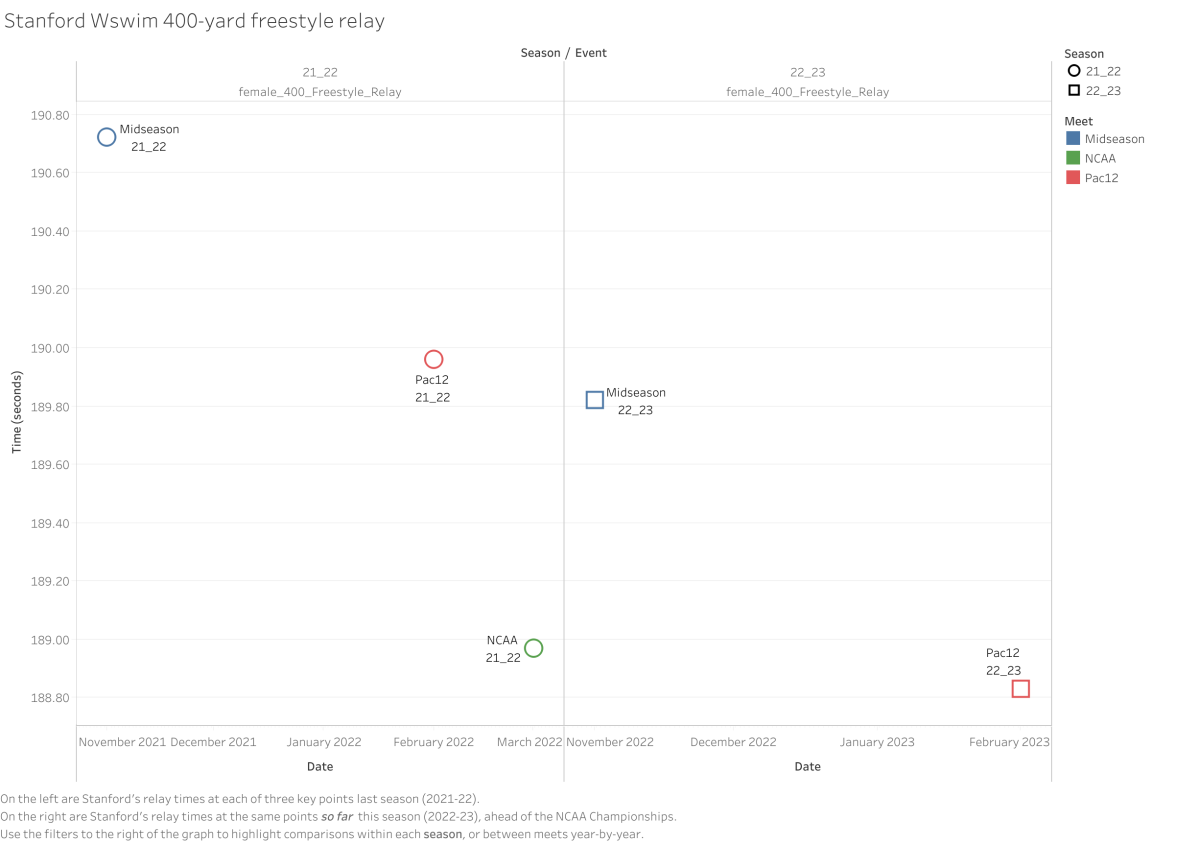
“We just do not have a ‘weak’ leg out of those four,” Meehan said.
All four will need to be at their best to stand a chance at closing the two-second gap to the Virginia Cavaliers in first-place with a 3:06.83 (the NCAA record), and it would require a school record performance. However, securing another podium finish appears a reasonable goal for the Cardinal.
400-yard medley relay
- Placing at 2021-22 NCAAs: 3rd
- Ranking pre-NCAAs 2022-23: 3rd
- Chance of 2022-23 podium finish, based on analysis: Good shot.
Last year’s team bronze medal came in the 400-yard medley relay.
Legs two through four of that relay were back behind the starting blocks at the conference championships in February, in Raab (breaststroke), Huske (butterfly) and Ruck (freestyle), while Curzan (backstroke) replaced the departed Smith on the lead-off.
That team stopped the clock at 3:25.79 for the Pac-12 title, meaning their best this season is just a few tenths shy of what they managed a year ago.
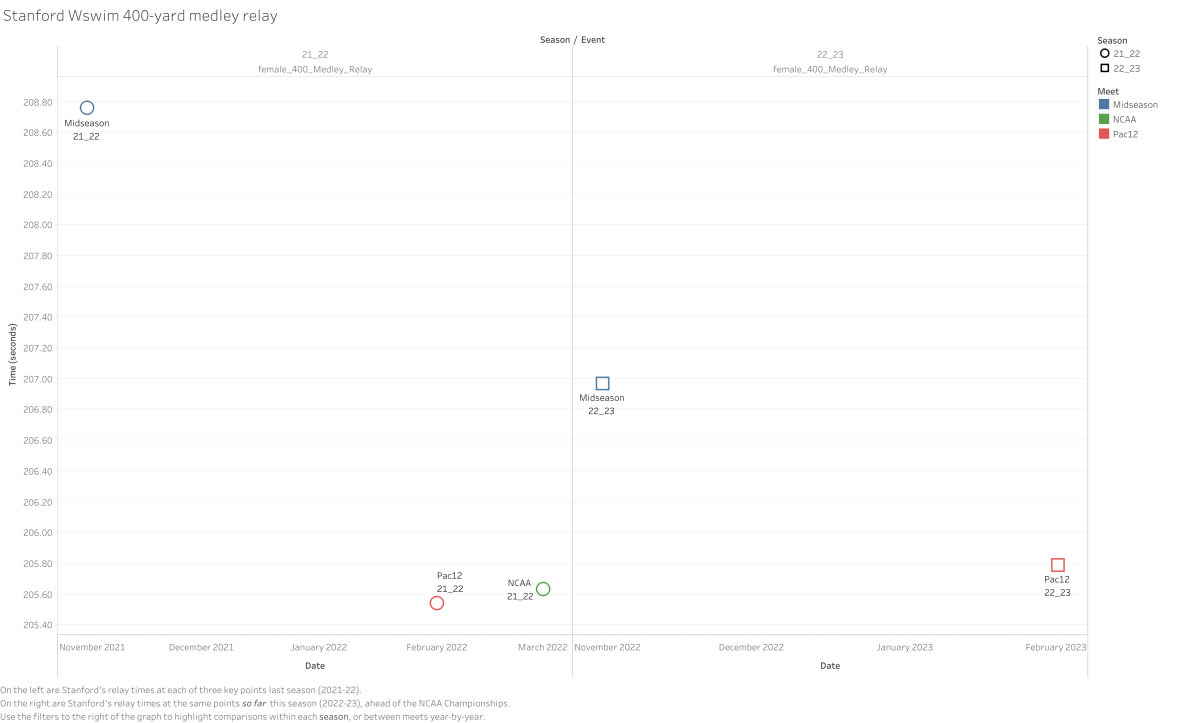
However, the potential to be even quicker in Knoxville is certainly there.
Curzan’s lifetime best 100-yard backstroke, 49.46 from the individual event at Pac-12s, would already put the Cardinal three tenths ahead of their effort last month.
Combine that with half a second’s worth of improvements across the other three legs (both Ruck and Raab were marginally faster at NCAAs last year than their splits at this year’s Pac-12s), and the team could scare No. 2-ranked Texas, who are entered for the national championships at 3:25.29.
It may be a stretch to reach the NCAA record of 3:21.80, where No. 1-ranked Virginia sits, but a return to the podium again looks to be within Stanford’s grasp.
800-yard freestyle relay
- Placing at 2021-22 NCAAs: 1st
- Ranking pre-NCAAs 2022-23: 1st
- Chance of 2022-23 podium finish, based on analysis: Lock it in.
This one is Stanford’s forte.
An off-year in 2021 aside, the Cardinal has been the national 800-yard freestyle relay champion every year from 2017 onwards, with last season’s margin of victory standing at just over five seconds.
The team hasn’t been as fast as that NCAA-winning 6:48.30 yet this season, but the 6:53.90 put up by Huske, Wilson, sophomore Lillie Nordmann and graduate student Morgan Tankersley at Pac-12s still makes Stanford the top-ranked team in the country heading into NCAAs.
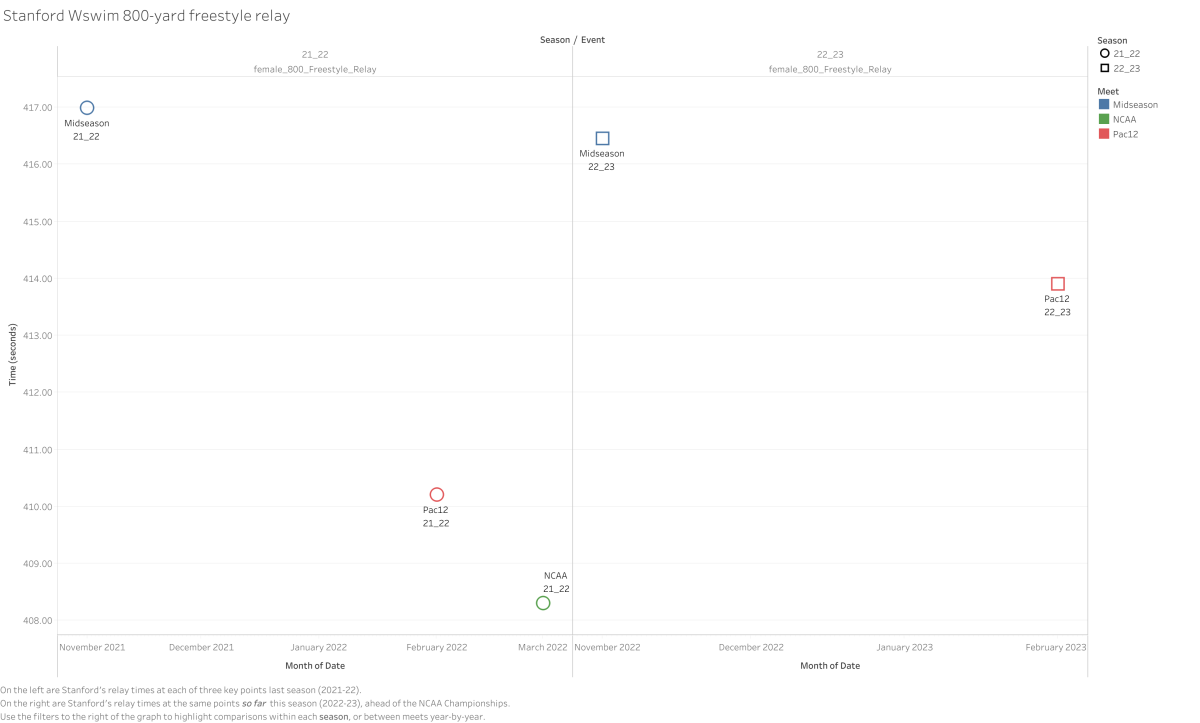
“If we load up on our 800 freestyle relay, I don’t believe there’s anybody that can beat us,” Meehan said.
“Loading up” will likely mean enlisting the help of a certain Canadian Olympian.
Ruck wasn’t needed for the win at Pac-12s; but as the defending NCAA champion in the individual 200-yard freestyle, with a 1:40.49 split in this very event last year (over a second quicker than any other Stanford swimmer, then or now), it’s highly likely that the fifth-year will return to the line-up in Wednesday’s opening session.
Entered in a 6:55.15, Virginia appears to be the main threat to a Stanford title here.
The Cavaliers may slot star junior Alex Walsh into their line-up, which could boost their performance by as much as three seconds compared to their conference meet. Still, Meehan believes the Cardinal at its best should have enough to win.
“I think that [Stanford’s] relay can go under 6:50,” Meehan said. “And there’s nobody else that’s going to be able to do that.”
Takeaways
Virginia, the two-time reigning champion overall, will be hard to bump out of first place in the four shorter distance relays (200 and 400-yard medley and freestyle relays), especially with the Cavaliers owning the NCAA record in each of those events from their Atlantic Coast Conference (ACC) meet just a month ago.
However, the Cardinal appear to be on track to continue their streak in the top three both overall, and for the 400-yard freestyle and medley relays.
Based on performances so far this season, there’s also a strong shot at a medal in the 200-yard freestyle, and the chance to rake in more points than last year in the 200-yard medley relay, even if a podium spot in the latter could prove elusive.
Lastly, it appears the 800-yard freestyle relay is once again Stanford’s to lose — and Meehan’s squad will look to take an early lead in the title race off the back of that event.
To find information on how to follow the team’s performance at NCAA’s, check the women’s swimming and diving schedule page here. The relays are scheduled as follows:
- Day 1 (Wednesday, March 15)
- 200-yard medley relay
- 800-yard freestyle relay
- Day 2 (Thursday, March 16)
- 200-yard freestyle relay
- Day 3 (Friday, March 17)
- 400-yard medley relay
- Day 4 (Saturday, March 18)
- 400-yard freestyle relay
The post A dive into the data: Why relays could be crucial to Stanford women’s swim success at NCAAs appeared first on The Stanford Daily.